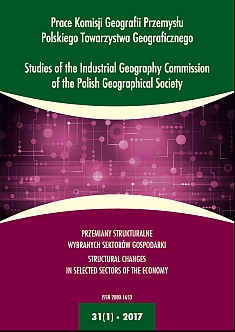The Impact of Spatial Proximity to Competitor, Supplier and Customer on Innovation Activity in Medium-Low Industry in Poland
DOI:
https://doi.org/10.24917/20801653.311.2Keywords:
competitor, customer, innovation activity, proximity, supplierAbstract
The aim of this study is to determine the impact of spatial proximity to customers, suppliers and competitors on innovation activity in medium-low technology manufacturing industries in Poland in the years 2008-2013. The scope of the survey relates to innovation at the company level and takes into account the diffusion to the “novelty to the company”. Innovative activities are divided into the following groups: investments in R&D and fixed assets not used so far such as buildings, premises and land; machinery and equipment, computer software; implementation of new products and processes; and innovative collaboration. The survey covers 2,301 industrial enterprises. It is assumed that innovation activity is facilitated by both local suppliers and customers, whereas it is impeded by local competitors. The methodological part of the study is based on probit modeling which enables to identify the probability of occurrence of innovation activity depending on geographical proximity of competitor, supplier and customer. The study shows that the impact of geographical proximity on innovation activity is diversified. The highest number of relationships relates to national suppliers and customers. The cooperation with foreign partners is positively correlated with R&D expenditures and propensity to cooperation with universities.
Downloads
Metrics
References
Ahuja, G. (2000). The duality of collaboration: Inducements and opportunities in the formation of interfirm linkages. Strategic Management Journal, 21(3), 317–343.
Aldrich, J.H., Nelson, F.D. (1984). Linear probability, logit, and probit models, 45, Sage.
Audretsch, B. (1998). Agglomeration and the location of innovative activity. Oxford Review of Economic Policy, 14(2), 18–29.
Bell, G.G. (2005). Clusters, networks, and firm innovativeness. Strategic Management Journal, 26, 287.
Bell, G.G., Zaheer, A. (2007). Geography, networks, and knowledge flow. Organization Science, 18, 955.
Boschma, R. (2005). Proximity and Innovation – a Critical Assessment. Regional Studies, 34(4), 213–229.
Bunnel, T., Coe, N. (2001). Spaces and scales of innovation. Progress in Human Geography, 25(4), 5695–89.
Cieślik, A., Michałek, J., Szczygielski, K. (2016). Innovations and Export Performance: Firm-level Evidence from Poland. Entrepreneurial Business and Economics Review, 4(4), 11–28.
Czakon, W. (2012). Sieci w zarządzaniu strategicznym. Warszawa: Oficyna Wolters Kluwer Business.
Dwojacki, P., Hlousek, J.(2008). Zarządzanie innowacjami. Gdańsk: Centrum Badawczo-Rozwojowe.
Dzikowski, P. (2016). Wpływ odległości od konkurenta, dostawcy i odbiorcy na aktywność innowacyjną przemysłu średnio-wysokiej i wysokiej techniki w Polsce. Współczesna Gospodarka, 7, 107–117.
Etzkowitz, H., Leydesdorff, L. (2000). The Dynamics of innovation: From national systems and ‘Mode 2’ to a triple helix of university-industry-government relations. Research Policy, 29, 109–123.
Freel, M.S. (2003). Sectoral patterns of small firm innovation, networking and proximity. Research Policy, 32(5), 751–770.
Gallaud, D., Torre, A. (2005). Geographical proximity and the diffusion of knowledge. W: G. Fuchs, P. Shapira, A. Koch (Eds.). Rethinking Regional Innovation and Change. Path Dependency or Regional Breakthrough? Dordrecht: Springer Verlag, 127–146.
Gertler, M.S. (2003). Tacit knowledge and the economic geography of context, or the undefinable taciness of being (there). Journal of Economic Geography, 3(1), 75–99.
Gilbert, B.A., McDougall, P.P., Audretsch D.B. (2008). Clusters, knowledge spillovers and new venture performance: An empirical examination. Journal of Business Venturing, 23(4), 405–422.
Gjelsvik, M. (2014). Capabilities for Innovation in a Globalizing World: from Nearly or at a Distance? Entrepreneurial Business and Economics Review, 2(2), 7–20.
Hatzichronoglou, T. (1997). Revision of the high-technology sector and product classification. Janasz, W., Kozioł-Nadolna, K. (2011). Innowacje w organizacji, Warszawa: PWN.
Kaczmarska-Krawczak, J. (2016). Wdrażanie innowacji w sektorze małych i średnich przedsię- biorstw na przykładzie regionu łódzkiego. Przedsiębiorczość Międzynarodowa, 2(1), 99–108.
Liao, T.F. (1994). Interpreting probability models: Logit, probit, and other generalized linear mo- dels, 101. Sage.
Majewska, J., Truskolaski, S. (2017). Spatial concentration of economic activity and competitiveness of Central European regions. Przedsiębiorczość Międzynarodowa, 3(1), 47–64.
Malerba, F. (2004). Sectoral Systems of Innovation. Cambridge: Cambridge University Press.
Mu, J., Peng, G., Love, E. (2008). Interfirm networks, social capital, and knowledge flow. Journal of Knowledge Management, 12(4), 86–100.
OECD (2008). Podręcznik Oslo: Zasady gromadzenia i interpretacji danych dotyczących innowacji. Warszawa.
Powell, W., Koput, K., Smith-Doerr, L. (1996). Interorganizational Collaboration and the Locus of Innovation: Networks of Learning in Biotechnology. Administrative Science Quarterly, 41(1), 116–145.
Rees, G., Lorenz, M., Vincent-Lancrin, S. (2001). OECD: Cities and Regions in the Learning Economy.
Center for Educational Research and Innovation (CERI). Rocznik statystyczny przemysłu (2014). Warszawa: GUS, 437.
Rogut, A. (2007). Modele sektorowego systemu innowacji. Raport ze studiów literaturowych. Łódź: Społeczna Wyższa Szkoła Przedsiębiorczości i Zarządzania w Łodzi, 7.
Saxenian, A. (1994). Lessons from silicon valley. Technology Review-Manchester NH-, 97, 42.
Stańczyk-Hugiet, E., Sus, A. (2012). Konsekwencje przynależności do sieci. W: J. Niemczyk, E. Stańczyk-Hugiet, B. Jasiński (red.) (2012). Sieci międzyorganizacyjne. Współczesne wyzwanie dla teorii i praktyki zarządzania. Warszawa: Wydawnictwo C.H. Beck, 87.
Storper, M. (1995), The resurgence of regional economics, ten years later: the region as a nexus of untraded interdependencies. European Urban and Regional Studies, 2(3), 191–221.
Świadek, A., Szopik-Depczyńska, K. (2011). Dostawcy w łańcuchu dostaw w kształtowaniu innowa- cyjności polskich regionów. Zeszyty Naukowe Szkoły Głównej Handlowej. Kolegium Gospodarki Światowej, 31.
Wach, K. (2016). Innovative Behaviour of High-Tech Internationalized Firms: Survey Results from Poland. Entrepreneurial Business and Economics Review, 4(3), 153–165.
Zaheer, A., Bell, G.G. (2005). Benefiting from Network position: firm capabilities, structural holes, and performance. Strategic Management Journal, 26(9), 809–825.
Downloads
Published
How to Cite
Issue
Section
License
Articles are published under the terms of the Creative Commons License (CC BY-ND 4.0; Attribution– NoDerivs).

